Sebastian Randel
Institute of Photonics and Quantum Electronics
Novel Phase-Noise-Tolerant Variational-Autoencoder-Based Equalization Suitable for Space-Division-Multiplexed Transmission
Sep 17, 2025Abstract:We demonstrate the effectiveness of a novel phase-noise-tolerant, variational-autoencoder-based equalization scheme for space-division-multiplexed (SDM) transmission in an experiment over 150km of randomly-coupled multi-core fibers.
Non-linear Equalization in 112 Gb/s PONs Using Kolmogorov-Arnold Networks
Nov 29, 2024Abstract:We investigate Kolmogorov-Arnold networks (KANs) for non-linear equalization of 112 Gb/s PAM4 passive optical networks (PONs). Using pruning and extensive hyperparameter search, we outperform linear equalizers and convolutional neural networks at low computational complexity.
Recent Advances on Machine Learning-aided DSP for Short-reach and Long-haul Optical Communications
Nov 15, 2024


Abstract:In this paper, we highlight recent advances in the use of machine learning for implementing equalizers for optical communications. We highlight both algorithmic advances as well as implementation aspects using conventional and neuromorphic hardware.
Advanced Equalization in 112 Gb/s Upstream PON Using a Novel Fourier Convolution-based Network
May 04, 2024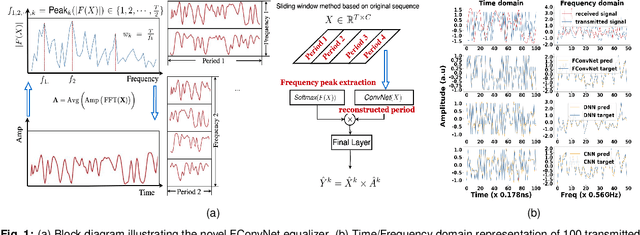


Abstract:We experimentally demonstrate a novel, low-complexity Fourier Convolution-based Network (FConvNet) based equalizer for 112 Gb/s upstream PAM4-PON. At a BER of 0.005, FConvNet enhances the receiver sensitivity by 2 and 1 dB compared to a 51-tap Sato equalizer and benchmark machine learning algorithms respectively.
CNN-Based Equalization for Communications: Achieving Gigabit Throughput with a Flexible FPGA Hardware Architecture
Apr 22, 2024

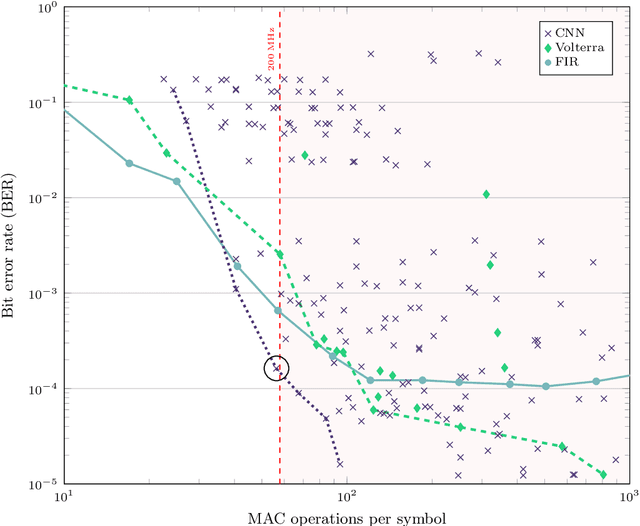
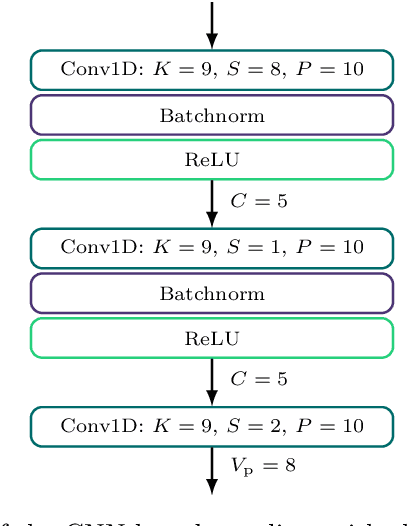
Abstract:To satisfy the growing throughput demand of data-intensive applications, the performance of optical communication systems increased dramatically in recent years. With higher throughput, more advanced equalizers are crucial, to compensate for impairments caused by inter-symbol interference (ISI). The latest research shows that artificial neural network (ANN)-based equalizers are promising candidates to replace traditional algorithms for high-throughput communications. On the other hand, not only throughput but also flexibility is a main objective of beyond-5G and 6G communication systems. A platform that is able to satisfy the strict throughput and flexibility requirements of modern communication systems are field programmable gate arrays (FPGAs). Thus, in this work, we present a high-performance FPGA implementation of an ANN-based equalizer, which meets the throughput requirements of modern optical communication systems. Further, our architecture is highly flexible since it includes a variable degree of parallelism (DOP) and therefore can also be applied to low-cost or low-power applications which is demonstrated for a magnetic recording channel. The implementation is based on a cross-layer design approach featuring optimizations from the algorithm down to the hardware architecture, including a detailed quantization analysis. Moreover, we present a framework to reduce the latency of the ANN-based equalizer under given throughput constraints. As a result, the bit error ratio (BER) of our equalizer for the optical fiber channel is around four times lower than that of a conventional one, while the corresponding FPGA implementation achieves a throughput of more than 40 GBd, outperforming a high-performance graphics processing unit (GPU) by three orders of magnitude for a similar batch size.
Real-Time FPGA Demonstrator of ANN-Based Equalization for Optical Communications
Feb 23, 2024

Abstract:In this work, we present a high-throughput field programmable gate array (FPGA) demonstrator of an artificial neural network (ANN)-based equalizer. The equalization is performed and illustrated in real-time for a 30 GBd, two-level pulse amplitude modulation (PAM2) optical communication system.
Fully-blind Neural Network Based Equalization for Severe Nonlinear Distortions in 112 Gbit/s Passive Optical Networks
Jan 17, 2024



Abstract:We demonstrate and evaluate a fully-blind digital signal processing (DSP) chain for 100G passive optical networks (PONs), and analyze different equalizer topologies based on neural networks with low hardware complexity.
Non-sliced Optical Arbitrary Waveform Measurement (OAWM) Using a Silicon Photonic Receiver Chip
Oct 21, 2023Abstract:Comb-based optical arbitrary waveform measurement (OAWM) techniques can overcome the bandwidth limitations of conventional coherent detection schemes and may have disruptive impact on a wide range of scientific and industrial applications. Over the previous years, different OAWM schemes have been demonstrated, showing the performance and the application potential of the concept in laboratory experiments. However, these demonstrations still relied on discrete fiber-optic components or on combinations of discrete coherent receivers with integrated optical slicing filters that require complex tuning procedures to achieve the desired performance. In this paper, we demonstrate the first wavelength-agnostic OAWM front-end that is integrated on a compact silicon photonic chip and that neither requires slicing filters nor active controls. Our OAWM system comprises four IQ receivers, which are accurately calibrated using a femtosecond mode-locked laser and which offer a total acquisition bandwidth of 170 GHz. Using sinusoidal test signals, we measure a signal-to-noise-and-distortion ratio (SINAD) of 30 dB for the reconstructed signal, which corresponds to an effective number of bits (ENOB) of 4.7 bit, where the underlying electronic analog-to-digital converters (ADC) turn out to be the main limitation. The performance of the OAWM system is further demonstrated by receiving 64QAM data signals at symbol rates of up to 100 GBd, achieving constellation signal-to-noise ratios (CSNR) that are on par with those obtained for conventional coherent receivers. In a theoretical scalability analysis, we show that increasing the channel count of non-sliced OAWM systems can improve both the acquisition bandwidth and the signal quality. We believe that our work represents a key step towards out-of-lab use of highly compact OAWM systems that rely on chip-scale integrated optical front-ends.
Slice-Less Optical Arbitrary Waveform Measurement (OAWM) in a Bandwidth of More than 600 GHz Using Soliton Microcombs
Mar 31, 2023



Abstract:We propose and demonstrate a novel scheme for optical arbitrary waveform measurement (OAWM) that exploits chip-scale Kerr soliton combs as highly scalable multiwavelength local oscillators (LO) for ultra-broadband full-field waveform acquisition. In contrast to earlier concepts, our approach does not require any optical slicing filters and thus lends itself to efficient implementation on state-of-the-art high-index-contrast integration platforms such as silicon photonics. The scheme allows to measure truly arbitrary waveforms with high accuracy, based on a dedicated system model which is calibrated by means of a femtosecond laser with known pulse shape. We demonstrated the viability of the approach in a proof-of-concept experiment by capturing an optical waveform that contains multiple 16 QAM and 64 QAM wavelength-division multiplexed (WDM) data signals with symbol rates of up to 80 GBd, reaching overall line rates of up to 1.92 Tbit/s within an optical acquisition bandwidth of 610 GHz. To the best of our knowledge, this is the highest bandwidth that has so far been demonstrated in an OAWM experiment.
KIGLIS: Smart Networks for Smart Cities
Jun 09, 2021
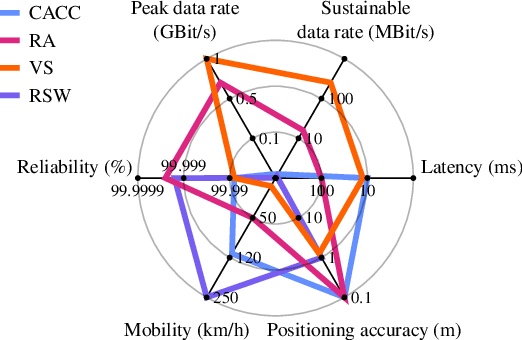
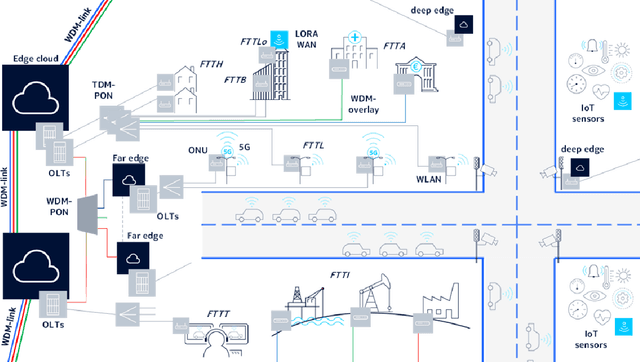
Abstract:Smart cities will be characterized by a variety of intelligent and networked services, each with specific requirements for the underlying network infrastructure. While smart city architectures and services have been studied extensively, little attention has been paid to the network technology. The KIGLIS research project, consisting of a consortium of companies, universities and research institutions, focuses on artificial intelligence for optimizing fiber-optic networks of a smart city, with a special focus on future mobility applications, such as automated driving. In this paper, we present early results on our process of collecting smart city requirements for communication networks, which will lead towards reference infrastructure and architecture solutions. Finally, we suggest directions in which artificial intelligence will improve smart city networks.
 Add to Chrome
Add to Chrome Add to Firefox
Add to Firefox Add to Edge
Add to Edge